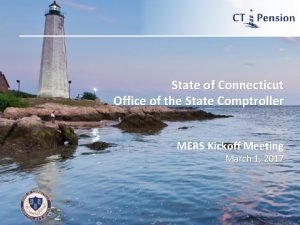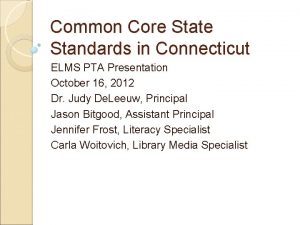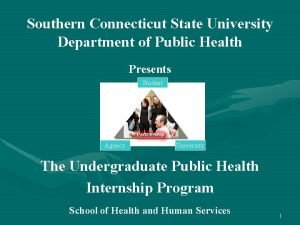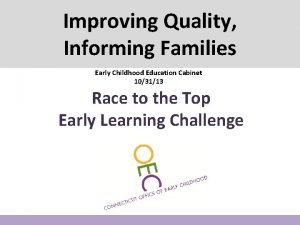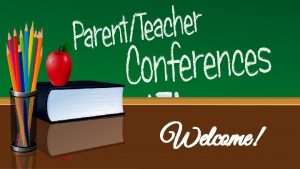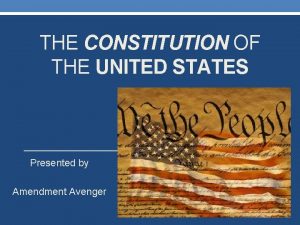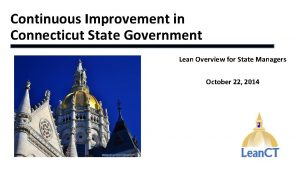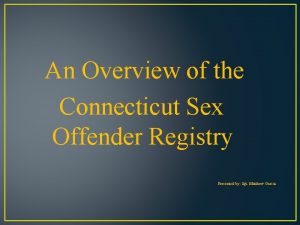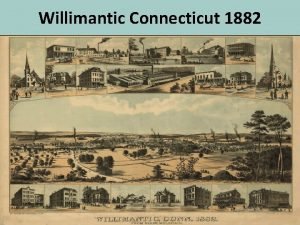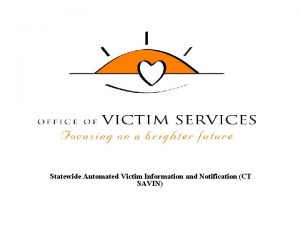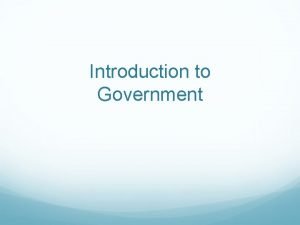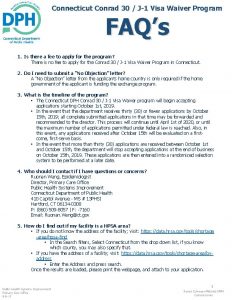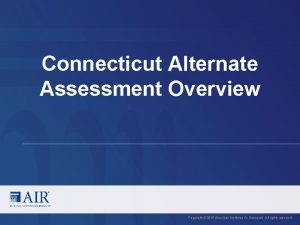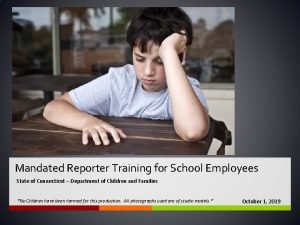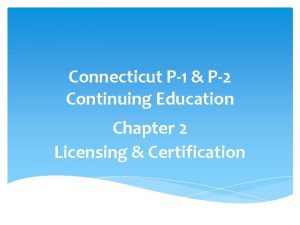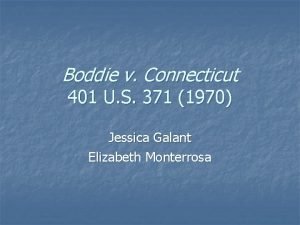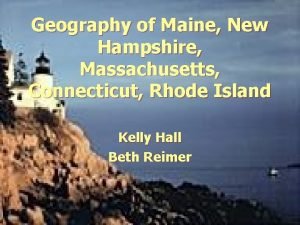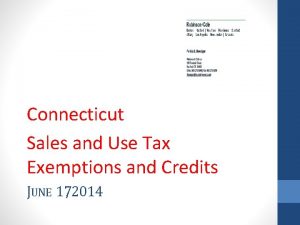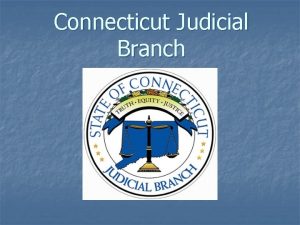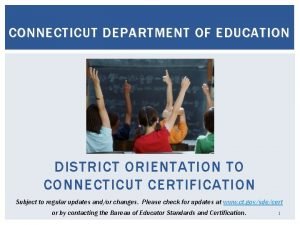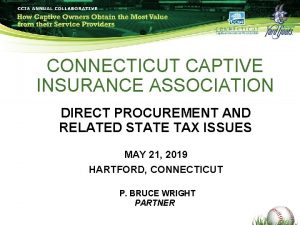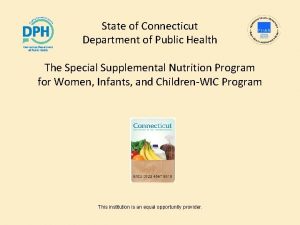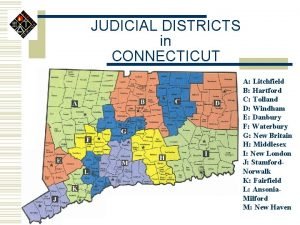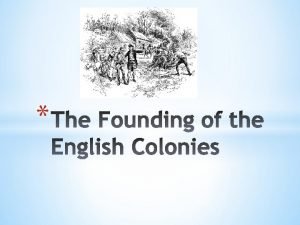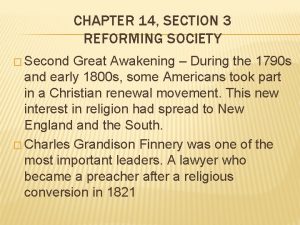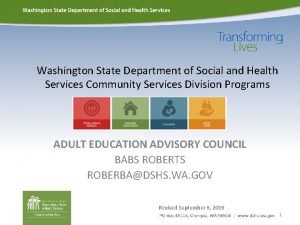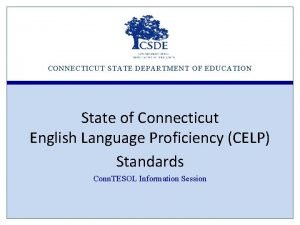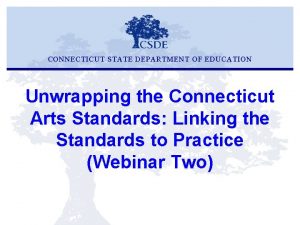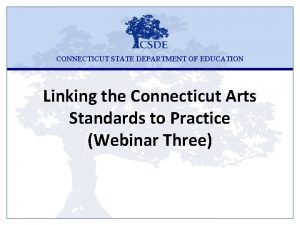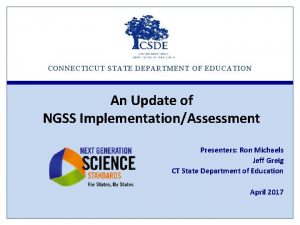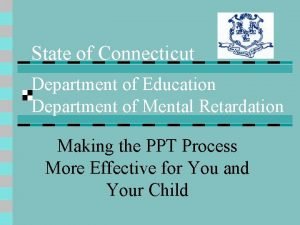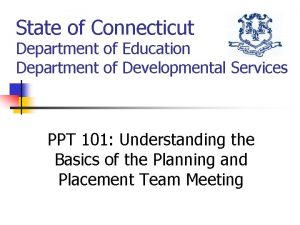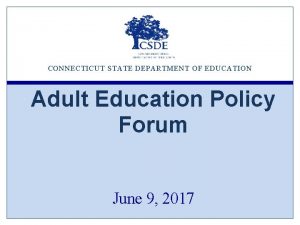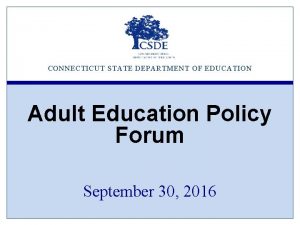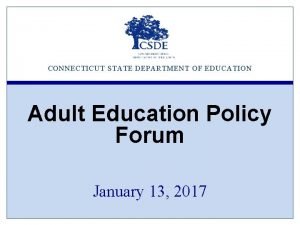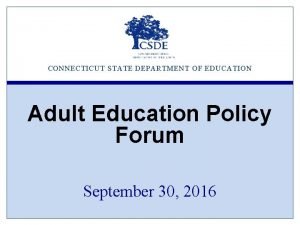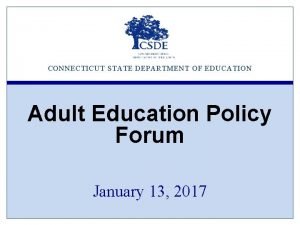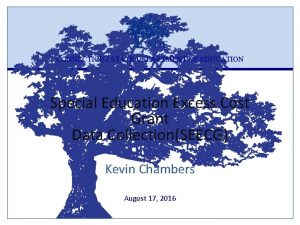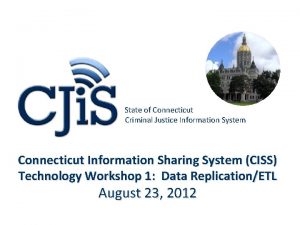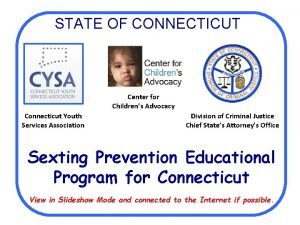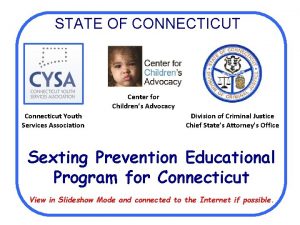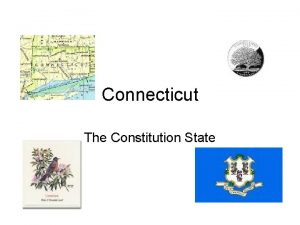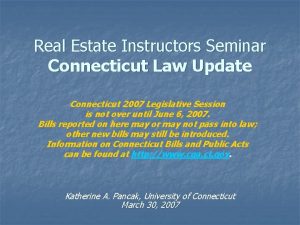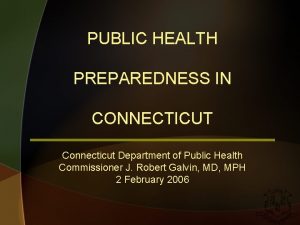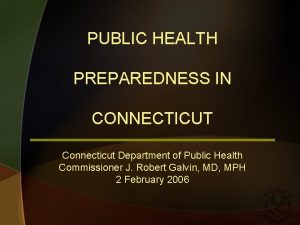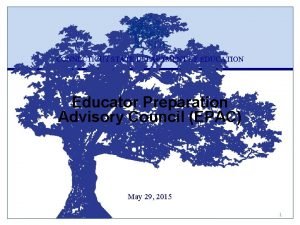CONNECTICUT STATE DEPARTMENT OF EDUCATION An Update of





























- Slides: 29

CONNECTICUT STATE DEPARTMENT OF EDUCATION An Update of NGSS Implementation/Assessment Presenters: Ron Michaels Jeff Greig CT State Department of Education April 2017

For the latest updates: http: //www. sde. ct. gov CONNECTICUT STATE DEPARTMENT OF EDUCATION

CONNECTICUT STATE DEPARTMENT OF EDUCATION * Subject to change dependent on federal and state law and policies. ** An option for transitioning away from current state standards to teaching NGSS. Districts have flexibility to develop their own transition and implementation plans. 3

Supporting Next Generation Science Connecticut State Department of Education in partnership with The Connecticut Science Center CONNECTICUT STATE DEPARTMENT OF EDUCATION

Building Capacity Leadership Development Academy (LDA) • Advanced professional development program • Prepares educators to lead expert developed institutes and short courses such as NGSX and Why NGSS…. ? • Graduates of this academy will become facilitators in supporting Connecticut’s transition to Next Generation Science CONNECTICUT STATE DEPARTMENT OF EDUCATION

Web-Based Learning • Next Generation Science- CT Short Course • No-cost • Self-paced • 11 modules offering 16 to 60 hours of structured professional learning • Last Module’s released in September, 2016 • No plans for any new modules (yet) • Next Gen Science Exemplar System (NGSX) • • • Hands-on, Expert-facilitated 6 module series over 4 ½ days Tuition fee of $1500 30 -36 hours of seminar-style learning Plans for several more “cohorts” have been announced CONNECTICUT STATE DEPARTMENT OF EDUCATION

A few more opportunities… • Curriculum Unit Development Institute • • • Designed for curriculum writers and teachers Expert facilitated 5 days Offered through the CT RESC system 2 presently available www. crec. org/protraxx/docs/362373/att. pdf www. learn. k 12. ct. us/Common/News 2/Home. Page. Pop. Ups/? Division. ID=0&Depart ment. ID=0&Sub. Department. ID=0&Calendar. ID=717718&i. Src=Top. Event Transitioning to NGSS: A Video Collection A collection of videos showing CT educators teaching 3 dimensional NGSS lessons in several classroom settings. • No cost/Self-paced • Released in October, 2016 CONNECTICUT STATE DEPARTMENT OF EDUCATION

More Opportunities to Come… • Why NGSS…? 2 -day NGSS Awareness PD • PLANS - Principals Learn About, Network, and Support 3 -Dimensional Science Learning • Evaluating Commercial Instructional Materials (Using the Achieve Equip Rubric vers. 3) • CSDE Sample Performance Tasks (Field Tests) • Development of storylines (MSP /TQP grants) CONNECTICUT STATE DEPARTMENT OF EDUCATION

NGSS Storylines Next Generation Science Storylines project is dedicated to providing tools that support teachers in developing, adapting, and teaching with strongly aligned NGSS materials in classrooms around the country. Check out the latest Storylines at http: //www. nextgenstorylines. org CONNECTICUT STATE DEPARTMENT OF EDUCATION

Phenomena Resources • Using Phenomena in NGSS-Designed Instruction (Interview with Brian Reiser) http: //www. nextgenscience. org/resources/phenomena http: //www. nextgenscience. org/sites/default/files/Using%20 Phenomena%20 in%20 NGSS. pdf • NGSS EQu. IP Rubric Using Phenomena http: //www. nextgenscience. org/resources/ngss-equip-rubric-using-phenomena • STEM Teaching Tools-Phenomenon http: //stemteachingtools. org/brief/28 • Integrating Science Practices Into Assessment Tasks (Research+ Practice Collaboratory) http: //researchandpractice. org/ngsstaskformats/ • Professional Development Tool: Qualities of a Good Anchor Phenomenon for a Coherent Sequence of Science Lessons http: //researchandpractice. org/resource/anchor_phenomena/ • Explaining Phenomena and Solving Problems as a Central Shift in the Next Generation Science Standards Vision for Science Teaching and Learning http: //scimath. unl. edu/noyce/conferences/2014/_files/slides/Campbell_NGSS. pdf • Developing Assessments for the NGSS the-ngss • 6 Steps to Coming Up with an Engaging Phenomenon to Anchor Your Next NGSS Unit https: //www. teachingchannel. org/blog/ausl/2015/04/15/6 -steps-to-coming-up-with-an-engaging-phenomenon-to-anchor-yournext-ngss-unit/ • Transitioning to the NGSS: Tips and Resources for Planning Science Units Around Puzzling Phenomena • https: //www. teachingchannel. org/blog/ausl/2014/09/22/transitioning-to-the-ngss-tips-and-resources-for-planning-science-unitsaround-puzzling-phenomena/ • Phenomena for NGSS (TJ Mc. Kenna)http: //www. ngssphenomena. com/ https: //www. rubicon. com/ngss-using-phenomenaengage-students/ https: //www. rubicon. com/offerings/professional-development/events/spark-ngss-using-phenomena-engagestudents/ (webinar) • #Project. Phenomena https: //concord. org/publications/newsletter/2014 -fall/developing-assessments-for- https: //sites. google. com/site/sciencephenomena/ CONNECTICUT STATE DEPARTMENT OF EDUCATION

CONNECTICUT STATE DEPARTMENT OF EDUCATION Update on Next Generation Science Assessments March/April 2017

State Science Assessments Online Starting with the spring, 2017 administration, almost all students will be tested online* in science using the same Test Delivery System (TDS) as Smarter Balanced. Further information about online testing, including brief practice tests, can be found on the CT Comprehensive Assessment Portal at http: //ct. portal. airast. org. Scheduling the online science assessments will be more flexible than in the past (i. e. , students can test on different days and times within a school). Note that the science assessments are timed tests and a science test session must be completed on a single day. * The main exceptions are students requiring a large-print or Braille version of the test as well as students placed out-of-state or in non-approved special education facilities. These students will take a paper-and-pencil version of the test. CONNECTICUT STATE DEPARTMENT OF EDUCATION

Proposed Science Assessment Timeline (2017 -) The Next Generation Science Standards (NGSS) were adopted by the CT State Board of Education on November 4, 2015. NGSS can be accessed at www. nextgenscience. org. Year Census Tests* Pilot/Field Tests 2017 Aligned to 2004 CT Science Standards Grades 5, 8 and 10 Aligned to NGSS Grades 5, 8 and 11 2018 Aligned to 2004 CT Science Standards Grades 5 and 8 only Aligned to NGSS Grades 5, 8 and 11 2019** and beyond Aligned to NGSS Grades 5, 8 and 11 * Includes the standard CMT and CAPT Science and the Skills Checklists Science. ** Low-stakes assessments in 2019 (results not included in school and district accountability). The CMT & CAPT Science administration window has moved starting in 2017: March 27 – April 28, 2017 CONNECTICUT STATE DEPARTMENT OF EDUCATION

Spring 2017 NGSS Assessment Pilot Test Purpose: to try out new assessment items and gather data/feedback. Dates: May 1 -26, 2017 Grades: 5, 8 and 11 (randomized, representative sample). All students within a grade should participate. * Districts/Schools Selected: Most districts in state, one or more schools in a district, only one grade per school. Administration: Online using AIR’s Test Delivery System (same used for Smarter Balanced and CMT/CAPT Science). Testing supports and accommodations will be available (e. g. , extended time, Text-to-Speech) Time: Approximately 1 hour plus 10 minutes for directions. Students do not need to be tested on same day or time (i. e. , can cycle students through rooms with computers over several days). Feedback: Students and teachers can complete optional feedback surveys. Sample Test Items: Will be available in mid-April (optional). * Exceptions includes students taking the CMT/CAPT Science Skills Checklist. There will be no large print or Braille versions available for the pilot test. CONNECTICUT STATE DEPARTMENT OF EDUCATION

NGSS Assessment Development CT is following recommendations and using resources from national experts and state collaborative efforts. This includes the National Research Council’s report: Developing Assessments for the Next Generation Science Standards*. CT is working with several other states and our testing contractor, American Institute for Research (AIR), to develop and share NGSS assessment resources and an item pool for statewide tests. NO national or multi-state consortium tests (e. g. , Smarter Balanced or PARCC) are anticipated for science. *Available through The National Academies Press at www. nap. edu. A practitioner’s guide for classroom teachers is also being developed. CONNECTICUT STATE DEPARTMENT OF EDUCATION

Proposed System of NGSS Assessments Formative Assessments Resources: Used every day by teachers to monitor student learning in the classroom and help make ongoing instructional adjustments to meet student learning needs. VOLUNTARY Interim Assessments Resources: Assessments administered at the end of units or grades to evaluate the learning of groups of students to inform curriculum and instruction at the local level. VOLUNTARY State Summative Assessments: Assessments given at end of learning (Grades 5, 8 and 11) to track student learning and inform decisions about curriculum, instruction, professional development, and policy for a variety of stakeholders. MANDATED BY FEDERAL AND STATE LAW Greater frequency of use More useful to students and teachers The goal is to provide useful information for a variety of purposes and audiences. Formative and interim assessment resources will likely come from a variety of sources and be shared by states around the country. CONNECTICUT STATE DEPARTMENT OF EDUCATION

NGSS State Summative Assessments Two main purposes: provide valid and reliable results at the individual student level and useful feedback to schools, districts and the state. Using evidence-based design approach: process of gathering evidence to make claims about student learning. This process was also used to develop Smarter Balanced. Assessment targets are also identified and reported. Content Domain (Science) Claims (broad reporting categories) Targets (specific reporting categories) CONNECTICUT STATE DEPARTMENT OF EDUCATION

DRAFT NGSS State Summative Assessment Design Claims and Reporting: One overall claim score (and performance levels) for Science that includes all three dimensions. Claim scores would be reported at the individual student level as well as the school, district and state levels. Additional claim scores may be reported for Life Science, Physical Science and Earth/Space Science that include all three dimensions. Additional scores/descriptors may be provided for Science and Engineering Practices and Crosscutting Concepts. Matrix Design: Different sets of items will be administered to different students. This design balances the need for valid and reliable individual student scores with providing more useful feedback for schools and districts. Tests will not be adaptive. Types and Number of Items: Each student would complete a variety of item types representative of Life, Physical and Earth/Space Sciences with approximately 40 items per student. Testing Time: Likely 90 -120 minutes depending on grade (will include embedded fieldtest items instead of a separate supplemental test session). CONNECTICUT STATE DEPARTMENT OF EDUCATION

DRAFT NGSS State Summative Assessment Design Target-level Reporting: The following may be available for schools and districts: • Topic Areas or DCI Arrangements + Engineering and Individual Performance Expectations • Groupings of Science and Engineering Practices • Groupings of Cross-Cutting Concepts The reporting descriptions shown above are consistent with Smarter Balanced assessments. CONNECTICUT STATE DEPARTMENT OF EDUCATION

NGSS State Summative Assessment Development Items are aligned to NGSS performance expectations (PEs) and evidence statements. Each item is aligned to at least 2 dimensions (DCIs, SEPs, CCCs). Using real-world scientific phenomena as a focus. A variety of stand-alone items and items clusters are being developed. Some item clusters align to more than one performance expectation (PE bundle). A variety of item types are being developed including innovative items such as interactions and simulations. A practice site for students will be developed this year. Items are based on specifications that include additional guidance about the PEs (e. g. acceptable vocabulary, content limits) that will eventually become public. More/less emphasis may be placed on certain topic areas and performance expectations based on feedback surveys of CT science education leaders. Using guidance from Smarter Balanced in terms of item formats, style, wording, etc. (modifying and adding to as needed for science) to maintain consistency. CONNECTICUT STATE DEPARTMENT OF EDUCATION

NGSS Online Assessment Items Start with stimuli based on real-world phenomena: • Written text • Data in tables or graphs • Diagrams, drawings, maps, etc. Use to answer • Animations • Simulations Items clusters present students with stimuli and items using a split screen. Variety of item types including: • Selected-Response • Constructed Response • Multi-Select • Graphic Response • Edit Task Inline Choice • Hot-Text Draggable • Table Input • Technology-Enhanced: • Interactions • Simulations New item types will be developed over time A variety of test accommodations and supports will be available to make the assessments accessible to all students. See the current version of the Assessment Guidelines at the CSDE Web site: www. ct. gov/sde CONNECTICUT STATE DEPARTMENT OF EDUCATION

Sample NGSS Assessment Items Sample NGSS assessment items for CT will be available mid-April through AIR’s assessment web portal at http: //ct. portal. airast. org/. Items will be added over time. California Sample NGSS Items: www. caaspp. org/practice-and-training/ (similar to items being developed for CT and collaborating states) CCSSO Science Assessment Item Collaborative (SAIC) Background on item clusters with prototypes for Grade 5 and high school http: //www. csai-online. org/spotlight/science-assessment-item-collaborative The Concord Consortium: https: //concord. org/projects/ngss-assessments Interactive NGSS assessment items (mostly focused on Middle School physical and life science with more to come. ) CONNECTICUT STATE DEPARTMENT OF EDUCATION

Sample NGSS Assessment Items: For CT Elementary School Example: 3 -PS 2 -3 Some questions not shown CONNECTICUT STATE DEPARTMENT OF

Sample NGSS Assessment Items: For CT Middle School Example MS-ESS 2 -4 Choices: Air temperature Amount of cloud cover Proportion of carbon dioxide in air in liquid form Proportion of oxygen in air Proportion of water in air in gas form Sunlight intensity Two additional graphs are included Same choices as shown above. Some questions not shown CONNECTICUT STATE DEPARTMENT OF EDUCATION

Sample NGSS Assessment Items: from California High School Example: HS-LS 3 -3 Some questions not shown CONNECTICUT STATE DEPARTMENT OF EDUCATION

NGSS Committees of CT Educators District Advisory Committee (DAC) Advise on “big picture” issues related to NGSS implementation, professional development, curriculum and assessment development. Includes science leaders and administrators representing over 100 school districts around the state. State Science Assessment Advisory Committee (SSAAC) Advise on the development of the NGSS assessment system. Help develop and review items for the statewide NGSS assessments. Includes approximately 60 science educators representing various districts, grades and content areas. Science Fairness and Accessibility Committee (FAC) Advise on fairness and accessibility issues for all students regardless of their background or abilities related to NGSS assessments. Includes approximately 20 educators with a variety of backgrounds and expertise. Contact Ron Michaels (Ronald. Michaels@ct. gov) if interested in the DAC. Contact Jeff Greig (Jeff. Greig@ct. gov) if interested in the SSAAC or FAC. CONNECTICUT STATE DEPARTMENT OF EDUCATION

NGSS Assessment Item Development Process (1 -2 Years) 1. Drafting of New Items by Testing Contractor* 2. CSDE Review of New Items 3. Content Review of New Items by SSAAC 4. Fairness and Accessibility Review of New Items 8. Scoring of Student Responses to New Items 7. Rubric Validation & Range-Finding of New Items 6. Pilot/Field Testing of New Items & Cognitive Labs 5. Expert Review of New Items 9. Data Review of Pilot/Field Tested Items 10. Building Operational Tests Only items deemed acceptable following reviews and pilot/field testing are placed on an operational test. *CT science educators from the State Science Assessment Advisory Committee (SSAAC) help generate phenomena and ideas for assessment items. CONNECTICUT STATE DEPARTMENT OF EDUCATION

Some NGSS Assessment Resources Next Generation Science Standards Classroom Tasks http: //www. nextgenscience. org/classroom-sample-assessment-tasks NSTA Next Generation Science Assessment Resources http: //ngss. nsta. org/conducting-assessments. aspx Steps to designing a three dimensional assessment http: //stemteachingtools. org/brief/29 How can assessments be designed to engage students in the range of science and engineering practices? http: //stemteachingtools. org/brief/26 Prompts for integrating crosscutting concepts into assessment and instruction http: //stemteachingtools. org/brief/41 The informal formative assessment cycle as a model for teacher practice http: //stemteachingtools. org/brief/16 How teachers can develop formative assessments that fit a three-dimensional view of science learning? http: //stemteachingtools. org/brief/18 Integrating science practices into assessment tasks http: //stemteachingtools. org/brief/30 CONNECTICUT STATE DEPARTMENT OF EDUCATION

Questions? For further information about science assessments in Connecticut contact: Jeff Greig CT State Department of Education Performance Office Jeff. Greig@ct. gov For information about NGSS implementation in Connecticut contact: Ron Michaels CT State Department of Education Academic Office Ronald. Michaels@ct. gov CONNECTICUT STATE DEPARTMENT OF EDUCATION
 Connecticut state comptroller
Connecticut state comptroller Shadow paging recovery technique
Shadow paging recovery technique Connecticut common core state standards
Connecticut common core state standards Public health internships ct
Public health internships ct State of ct division of criminal justice
State of ct division of criminal justice Connecticut early childhood education cabinet
Connecticut early childhood education cabinet Oklahoma 3rd grade math standards
Oklahoma 3rd grade math standards Connecticut compromise
Connecticut compromise Decd
Decd Connecticut college transfer
Connecticut college transfer Megan kanka
Megan kanka Willimantic ct map
Willimantic ct map Vinelink texas statewide
Vinelink texas statewide Principle of separation of powers
Principle of separation of powers Connecticut conrad 30
Connecticut conrad 30 Ct alternate assessment training portal
Ct alternate assessment training portal Mandated reporter training ct
Mandated reporter training ct Ct p1 continuing education
Ct p1 continuing education Boddie v. connecticut
Boddie v. connecticut Maine coastline length
Maine coastline length Connecticut manufacturing sales tax exemption
Connecticut manufacturing sales tax exemption Case management information system
Case management information system Teacher certification lookup ct
Teacher certification lookup ct Connecticut captive insurance association
Connecticut captive insurance association Wic juice
Wic juice Connecticut judicial districts
Connecticut judicial districts Csde tcs
Csde tcs John haynes connecticut
John haynes connecticut Started an all-female academy in hartford, connecticut.
Started an all-female academy in hartford, connecticut. Washington state department of social and health services
Washington state department of social and health services
